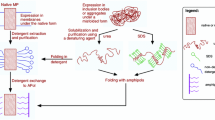Abstract
A series of amphiphilic polymethylenecarboxymaleimides has been synthesized for use as sulfhydryl reagents applicable to membrane proteins. Physical properties of the compounds which are relevant to their proposed mode of action have been determined. By comparing rates of reaction in aqueous and aprotic solvents, the compounds have been shown to react exclusively with the thiolate ion. The effects of the reagents on three membrane-associated proteins are reported, and in two cases a comparative study has been made of the effects on the proteins in the absence of membranes. A mechanism is proposed whereby the reagents are anchored at the lipid/water interface by the negatively charged carboxyl group, thus siting the reactive maleimide in a plane whose depth is defined by the length of the reagent. Supporting evidence for this model is provided by the inability of the reagents to traverse membranes, and variation of their inhibitory potency with chain length when the proteins are embedded in the membrane, but not when extracted into solution. As examples of general use of the reagents to probe sulfhydryl groups in membrane proteins, the reagents have been used to (a) determine the depths in the membrane at which two populations of sulfhydryl groups occur in the mitochondrial phosphate transporter; (b) locate a single sulfhydryl associated with the active site ofD-β-hydroxybutyrate dehydrogenase in the inner mitochondrial membrane; (c) examine sulfhydryl groups in theD-3-glyceraldehyde phosphate dehydrogenase associated with the human red blood cell membrane.
Similar content being viewed by others
References
Allen, J. P., Feher, G., Yeates, T. O., Komiya, H., and Rees, D. C. (1988).Proc. Natl. Acad. Sci. USA 85, 8487–8491.
Bacher, M. A., and Wheeler, K. P. (1985).Biochem. Soc. Trans. 13, 700–701.
Blair, P. V. (1967).Methods Enzymol. 10, 78–81.
Bock, H-G., and Fleischer, S. (1974).Methods Enzymol. 32, 374–391.
Bock, H-G., and Fleischer, S. (1975).J. Biol. Chem. 250, 5774–5781.
Bose, A. K., Greer, F., and Prior, C. C. (1985).J. Org. Chem. 1335–1338.
Chappel, J. B., and Crofts, A. P. (1966). InRegulation of Metabolic Processes in Mitochondria, Vol. 7, BBA Library, Elsevier, Amsterdam, 273–278.
Chasteen, M. O. (1983).Trends Biochem. Sci. 8, 272–275.
Churchill, P., Brenner, S. C., Partis, M. D., Griffiths, D. G., Beechey, R. B., and Fleischer, S. (1982).Fed. Proc. 41, 6570.
Dalton, E., McIntyre, J. O., and Fleischer, S. (1984).Biophys. J., 147a.
El-Sharif, A., and Banner, M. (1985).Biochem. Soc. Trans. 13, 252–253.
Felberg, N. T., and Hollocher, T. C. (1972).J. Biol. Chem. 247, 4539–4542.
Findlay, J. B. C., and Pappin, D. J. C. (1986).Biochem. J. 238, 625–642.
Fleischer, S., Meissner, G., Smigel, M., and Wood, R. (1974).Methods Enzymol. 71, 292–299.
Fonyo, A. (1974).Biochem. Biophys. Res. Commun. 57, 1069–1073.
Fonyo, A., Ligetti, E., Palmieri, F., and Quagliarello, E. (1975). InBiomembranes-Structure and Function. FEBS Symposium 35 Gardes, G., and Szasz, S., (eds.), Akadamiai Kiado, Budapest, pp. 287–304.
Gray, T. M., and Matthews, B. W. (1984).J. Mol. Biol. 175, 75–81.
Gregory, J. D. (1955).J. Am. Chem. Soc. 77, 3922–3923.
Griffiths, D. G. (1984).Ph. D. Thesis, University of Kent.
Griffiths, D. G., Partis, M. D., Sharp, R. N., and Beechey, R. B. (1981).FEBS Lett. 134, 261–263.
Griffiths, D. G., Pringle, M. J., Hughes, J. B., and Sanadi, D. R. (1984).J. Bioenerg. Biomembr. 16, 465–475.
Hadvary, P., and Kadenbach, B. (1976).Eur. J. Biochem. 67, 573–581.
Heitz, J. P., Anderson, C. D., and Anderson, B. M. (1968).Arch. Biochem. Biophys. 127, 627–636.
Holton, F. A., and Beechey, R. B. (1959).Biochem. J. 73, 29p.
Houstek, J., Bertoli, E., Stipeni, I., Pavelka, S., Megli, J., and Palmieri, F. (1982).Proc. 2nd European Bioenergetics Conf., Lyon, France, pp. 479–480.
Houstek, J., Bertoli, E., Stipeni, I., Pavelka, S., Megli, J., and Palmieri, F. (1983)FEBS Lett. 154, 185–190.
Ikemoto, N. (1982).Annu. Rev. Physiol. 44, 297–317.
Jennings, M. L. (1989).Annu. Rev. Biochem. 58, 999–1027.
Jorgenson, P. L. (1982).Biochim. Biophys. Acta. 694, 27–68.
Kenney, W. C. (1975).J. Biol. Chem. 250, 3089–3094.
Kilman, H. J., and Steck, T. L. (1980).J. Biol. Chem. 250, 9176–9184.
Klingenberg, M., Durand, R., and Guerin, B. (1974).Euro. J. Biochem. 42, 135–150.
LeQuoc, K., LeQuoc, D., and Gaudemer, Y. (1981).Biochemistry 20, 1705–1710.
MacDonald, P. M., McDonough, B., Sykes, B. D., and McElhaney, P. N. (1983).Biochemistry 23, 4496.
MacDonald, P. M., Sykes, B. D., McElhaney, P. M., and Gunstone, F. D. (1985).Biochemistry 24, 177–184.
McConnell, H. M., and Farland, B. G. (1975).Ann. N.Y. Acad. Sci. 195, 207.
Moore, R. J., and Beechey, R. B. (1984).Biochem. Soc. Trans. 13, 690–691.
Moore, A. L., Proudlove, M. O., Partis, M. D., and Beechey, R. B. (1984). InAdvances in Photosynthesis Research. Vol III (Sybesma, E., ed.), Nihoff/Junk, The Hague, pp. 9.902–9.912.
Rees, D. C., Komiya, H., Yeates, T. O., Allen, D. P. and Feher, G. (1989).Annu. Rev. Biochem. 58, 607–633.
Rich, D. H., Gesellschen, P. D., Tong, A., Cheung, A., and Buckner, C. K. (1975).J. Med. Chem. 18, 1004–1010.
Schaper, K. J. (1982).Quant. Struct. Act. Rel. 1, 13–27.
Schnaitman, C. A., and Greenwalt, J. W. (1968).J. Cell. Biol. 38, 158–175.
Searle, N. E. (1948). U.S. Patent No. 2444536.
Steck, T. L., and Kant, J. A. (1974).Methods Enzymol. 31, 172–180.
Tausky, H. H., and Schorr, E. (1953).J. Biol. Chem. 202, 675–685.
Tsou, K. C., Barnett, R. J., and Seligman, A. M. (1955).J. Am. Soc. 77, 4613–4617.
Tyler, D. D. (1969).Biochem. J. 111, 665–668.
Tyler, D. D. (1980).Biochem. J. 192, 821–828.
Veeger, C., Devertanian, D. V., and Zeelimaker, W. P. (1969).Methods Enzymol. 12, 84–86.
Wohlrab, H. (1978).Biochem. Biophys. Res. Commun. 83, 1430–1435.
Author information
Authors and Affiliations
Rights and permissions
About this article
Cite this article
Griffiths, D.G., Partis, M.D., Churchill, P. et al. The use of amphipathic maleimides to study membrane-associated proteins. J Bioenerg Biomembr 22, 691–707 (1990). https://doi.org/10.1007/BF00809072
Received:
Revised:
Issue Date:
DOI: https://doi.org/10.1007/BF00809072




